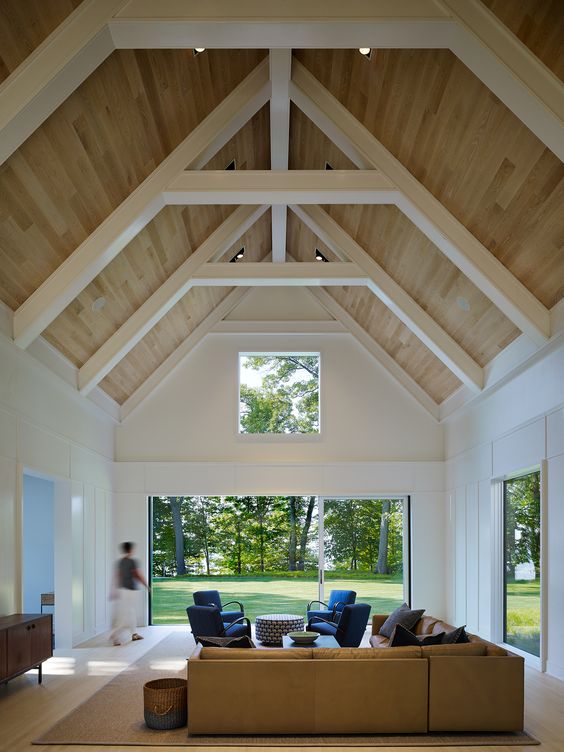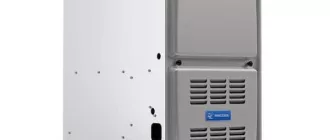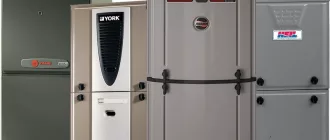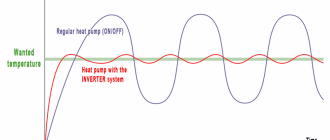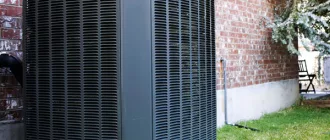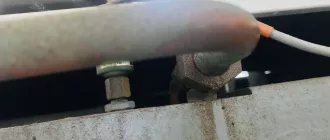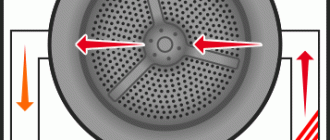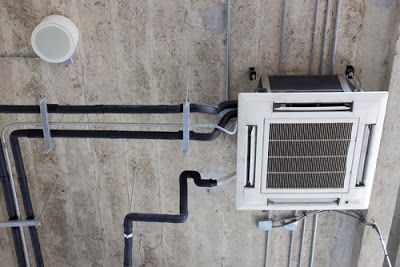
The Pros and Cons of High Ceilings, HVAC Edition
When it comes to designing and installing HVAC systems, the height of the ceilings plays a significant role in the overall performance and efficiency. High ceilings offer a sense of spaciousness and grandeur, creating an appealing visual aesthetic. However, they also present unique challenges that need to be carefully considered in order to optimize the HVAC system for effectiveness and cost-efficiency.
One of the pros of high ceilings in HVAC systems is enhanced air circulation. With more vertical space available, warm air tends to rise and accumulate at the top. This allows for effective ventilation and helps distribute conditioned air evenly throughout the room. As a result, occupants can enjoy consistent comfort levels regardless of their position in the space.
Another advantage is improved cooling and heating capabilities. High ceilings allow for more air volume and circulation, enabling the HVAC system to cool or heat a larger area effectively. This is especially beneficial in spaces with a vast floor area, such as warehouses or open-concept offices. The HVAC system can operate more efficiently, saving energy and reducing utility costs.
However, there are also several cons to consider when dealing with high ceilings in HVAC systems. One of the main challenges is the increased difficulty in maintaining consistent temperature levels. Because warm air rises, it can create temperature stratification, where the upper portion of the space becomes significantly warmer than the lower areas. This can lead to discomfort for occupants, as well as potential energy waste as the HVAC system struggles to cool or heat the entire space evenly.
The Benefits of High Ceilings in HVAC Systems
High ceilings in HVAC systems offer several advantages over lower ceilings. Here are some of the pros of having high ceilings in your HVAC system:
- Better air circulation: High ceilings allow for better air circulation throughout the space. The increased vertical space helps distribute the air more evenly, ensuring that every corner of the room receives adequate airflow.
- Improved energy efficiency: HVAC systems with high ceilings tend to be more energy-efficient. The extra overhead space allows for better air distribution, reducing the strain on the HVAC unit and allowing it to operate at a lower capacity.
- Enhanced comfort: With high ceilings, occupants can experience improved comfort levels. The increased airflow and better distribution of conditioned air help maintain consistent temperatures and reduce hot and cold spots within the space.
- Flexibility in design: High ceilings offer more design flexibility, allowing for creative architectural elements such as exposed ductwork or unique lighting fixtures. This can enhance the aesthetic appeal of the space and create a visually pleasing environment.
- Reduced noise levels: Higher ceilings can help reduce noise levels within the space. The additional space between the occupants and the HVAC system can help dampen noise and create a quieter environment.
In conclusion, high ceilings can provide numerous benefits in HVAC systems, ranging from improved air circulation and energy efficiency to enhanced comfort and design flexibility. It is important to consider these pros when planning and designing HVAC systems for spaces with high ceilings.
The Challenges of High Ceilings for HVAC Systems
Installing HVAC systems in buildings with high ceilings presents both pros and cons for building owners and HVAC professionals. While high ceilings can provide a sense of spaciousness and aesthetic appeal, they also pose several challenges for efficient HVAC system operation and maintenance.
1. Increased Energy Consumption: One of the main challenges of high ceilings is the increased volume of air that needs to be conditioned. With larger spaces to heat or cool, HVAC systems may have to work harder and consume more energy to maintain desired indoor temperatures.
2. Inefficient Air Distribution: High ceilings often result in poor air distribution throughout the space. Warm air tends to rise, while cool air settles near the floor. This can lead to temperature stratification, with significant temperature differences at different levels of the room. To overcome this challenge, additional air circulation devices or strategically placed ductwork may be required.
3. Difficulty in Airflow Control: Controlling the airflow in high-ceilinged spaces can be challenging. The increased air volume and longer duct runs can result in reduced airflow velocity and pressure, making it difficult to achieve the desired air circulation and ventilation rates.
4. Increased Maintenance Costs: Maintaining HVAC systems in high-ceilinged spaces can be more labor-intensive and time-consuming. Technicians may require specialized equipment and safety measures to access and service components located at elevated heights. This can increase maintenance costs and downtime for HVAC systems.
5. Noise and Aesthetic Concerns: In some cases, high ceilings can amplify noise levels in the space. HVAC equipment, such as air handlers and ductwork, may generate noise that is more noticeable in rooms with higher ceilings. Additionally, the installation of HVAC equipment and ductwork may affect the aesthetic appeal of the space, requiring careful planning and design considerations.
In conclusion, high ceilings in buildings present challenges for HVAC systems in terms of increased energy consumption, inefficient air distribution, difficulty in airflow control, increased maintenance costs, and potential noise and aesthetic concerns. HVAC professionals and building owners need to carefully assess these challenges and implement appropriate solutions to ensure optimal performance and comfort in high-ceilinged spaces.
The Role of Proper Insulation in High Ceiling HVAC Systems
Proper insulation plays a crucial role in high ceiling HVAC systems. The unique design of high ceilings presents specific challenges in maintaining a comfortable indoor climate. To overcome these challenges, proper insulation is essential to ensure the efficient operation of the HVAC system and provide optimal comfort for occupants.
One of the main advantages of proper insulation in high ceiling HVAC systems is its ability to prevent heat loss or gain. High ceilings create a larger volume of air that needs to be heated or cooled, and without sufficient insulation, this can result in significant energy loss. Insulation acts as a barrier, reducing heat transfer through the ceilings and walls, and minimizing energy consumption.
Additionally, proper insulation helps to improve air quality in high ceiling spaces. HVAC systems not only control temperature but also circulate and filter the air. Without insulation, air leakage can occur, allowing pollutants and allergens to enter the space. Insulation helps to create an airtight seal, preventing outside contaminants from infiltrating the indoor environment and ensuring a healthier indoor air quality.
Another benefit of proper insulation in high ceiling HVAC systems is its impact on noise reduction. High ceilings can create acoustical challenges, as sound tends to travel and reverberate more in larger spaces. Insulation acts as a sound barrier, absorbing and dampening noise, and reducing the overall noise levels in the space. This is particularly important in commercial settings such as offices or public venues, where a quieter environment is desired for improved productivity and comfort.
However, it’s worth noting that there are some potential drawbacks to consider when it comes to insulation in high ceiling HVAC systems. Firstly, the installation and maintenance of insulation can be costly, especially in large spaces with high ceilings. Additionally, improper insulation installation or maintenance can lead to moisture issues, such as condensation or mold growth, which can be detrimental to both the building and occupants’ health.
In conclusion, proper insulation is crucial in high ceiling HVAC systems to optimize energy efficiency, improve air quality, and reduce noise levels. While there are potential drawbacks to consider, the pros of proper insulation in high ceiling HVAC systems outweigh the cons when it comes to creating a comfortable and healthy indoor environment.
The Impact of High Ceilings on HVAC System Efficiency
When it comes to HVAC systems, the height of the ceilings can have a significant impact on the overall efficiency of the system. High ceilings, which are typically found in commercial and industrial buildings, present both pros and cons when it comes to heating, ventilation, and air conditioning.
One of the pros of high ceilings is the increased volume of air that can be circulated within the space. This can be beneficial in buildings where a large number of people are present, as it allows for better air distribution and improved indoor air quality. Additionally, the increased ceiling height can provide better ventilation, allowing for the removal of stale air and the introduction of fresh outdoor air.
On the other hand, high ceilings can also pose challenges for HVAC system efficiency. The increased volume of air that needs to be conditioned requires more energy, resulting in higher energy costs. Additionally, the longer duct runs associated with high ceilings can lead to increased pressure drop and reduced airflow, negatively impacting the performance of the system.
In order to mitigate these cons and improve HVAC system efficiency in buildings with high ceilings, several strategies can be implemented. For example, the use of variable air volume (VAV) systems can help to optimize airflow and reduce energy consumption. Additionally, the installation of ceiling fans or the use of vertical ventilation can aid in improving air distribution and reducing temperature stratification.
In conclusion, high ceilings in HVAC systems have their pros and cons when it comes to efficiency. While they can allow for better air circulation and ventilation, they also present challenges in terms of increased energy consumption and reduced airflow. By implementing appropriate strategies, however, these challenges can be overcome, resulting in a more efficient HVAC system in buildings with high ceilings.
The Influence of High Ceilings on HVAC System Airflow
When it comes to HVAC systems, the height of the ceilings in a building can have a significant impact on the airflow. High ceilings, typically found in buildings such as warehouses and factories, present both pros and cons in terms of HVAC system performance.
Pros:
One of the advantages of high ceilings is the ample space it provides for the proper distribution of air. With more vertical space, the HVAC system can deliver conditioned air with greater efficiency and coverage. This can be particularly beneficial in large spaces where uniform temperature and air quality are desired.
Additionally, high ceilings allow for better air circulation, as the conditioned air can reach further distances before it encounters any obstructions. This can help improve the overall ventilation in the building and ensure a more comfortable environment for occupants.
Cons:
However, high ceilings can also pose some challenges for HVAC systems. The increased vertical space means that the conditioned air needs to travel a greater distance to reach the occupied zone. This can result in higher energy consumption and may require the HVAC system to work harder to maintain the desired temperature and ventilation levels.
Furthermore, high ceilings can lead to stratification of air, where warmer air rises to the top while cooler air sinks to the lower areas. This temperature difference can create discomfort and uneven distribution of conditioned air throughout the space. It may require the use of additional equipment, such as fans or air circulators, to mitigate this issue.
In conclusion, while high ceilings offer advantages in terms of air distribution and circulation, they can also present challenges for HVAC systems in terms of energy consumption and temperature stratification. Proper design and consideration of these factors are essential to ensure optimum performance and comfort in buildings with high ceilings.
The Importance of Maintenance in High Ceiling HVAC Systems
Maintenance is a crucial aspect of any HVAC system, and this holds especially true for high ceiling HVAC systems. These systems come with their own set of unique challenges and requirements, making regular maintenance even more important.
One of the main reasons why maintenance is crucial for high ceiling HVAC systems is their design and installation. These systems are typically installed in buildings with high ceilings, which means that they have to work harder to distribute air effectively throughout the space. This increased workload can put a strain on the components of the HVAC system, making them more prone to breakdowns and malfunctions.
Regular maintenance helps to keep these systems running smoothly and efficiently. It allows HVAC technicians to identify and address any issues before they become major problems. By conducting routine inspections, cleaning, and lubrication, technicians can ensure that all components are functioning properly and that any potential issues are addressed early on.
Maintenance also helps to extend the lifespan of high ceiling HVAC systems. With proper care and regular maintenance, these systems can last much longer, saving building owners and managers significant amounts of money in the long run. By investing in regular maintenance, they can avoid costly repairs and premature replacements.
Another important aspect of maintenance in high ceiling HVAC systems is energy efficiency. These systems are already energy-intensive due to their design and the increased workload required to distribute air effectively. Regular maintenance helps to optimize their performance, ensuring that they operate at peak efficiency. This not only reduces energy consumption and costs but also has a positive impact on the environment.
| – Improved system performance | – Higher maintenance costs |
| – Extended system lifespan | – Potential downtime during maintenance |
| – Increased energy efficiency | – Disruption to building occupants |
| – Cost savings in the long run | – Need for specialized technicians |
In conclusion, maintenance plays a critical role in ensuring the optimal performance, longevity, and energy efficiency of high ceiling HVAC systems. Despite the potential cons, the pros far outweigh the cons, making regular maintenance a worthwhile investment for building owners and managers.
The Cost Considerations of High Ceiling HVAC Systems
When it comes to HVAC systems, high ceilings can pose both pros and cons. While high ceilings can provide a sense of spaciousness and aesthetic appeal, they can also impact the efficiency and cost of heating and cooling a space.
| Pros | Cons |
| 1. Improved air circulation due to the larger volume of space. | 1. Increased energy consumption due to the larger space to heat or cool. |
| 2. Enhanced comfort as air is distributed evenly throughout the room. | 2. Higher installation and maintenance costs. |
| 3. Reduced noise levels as air flows over larger distances. | 3. More challenging temperature control. |
One of the main cost considerations of high ceiling HVAC systems is the increased energy consumption. The larger volume of space in rooms with high ceilings requires more heating or cooling to maintain the desired temperature, leading to higher energy bills. This can be particularly significant in commercial buildings or large residential spaces with numerous high ceiling areas.
Additionally, the installation and maintenance costs of high ceiling HVAC systems tend to be higher compared to systems in rooms with standard ceilings. HVAC components, such as ductwork and vents, might need to be sized or positioned differently to accommodate the height of the ceilings. This can result in additional materials and labor expenses during installation and future maintenance or repairs.
Another challenge of high ceiling HVAC systems is achieving precise temperature control. The increased vertical space can make it more difficult to evenly distribute conditioned air throughout the room, leading to temperature variations. This might require specialized HVAC equipment or zoning systems to ensure consistent comfort levels, which can further increase the overall cost of the system.
In conclusion, while high ceilings in HVAC systems offer advantages such as improved air circulation and reduced noise levels, they also come with additional costs and challenges. To make an informed decision, it is crucial to evaluate the specific requirements and limitations of the space, considering both the pros and cons of high ceiling HVAC systems.
The Effect of High Ceilings on HVAC System Noise
When considering the pros and cons of high ceilings in HVAC systems, one important factor to consider is the effect on system noise. High ceilings can have both positive and negative effects on the noise levels of an HVAC system.
- Pro: Reduced Noise Levels – One advantage of high ceilings is that they can help to reduce the noise levels of an HVAC system. With more space above, the sound waves have greater room to dissipate and disperse, resulting in a quieter environment for building occupants.
- Con: Echo and Reverberation – On the other hand, high ceilings can also contribute to echo and reverberation, which can increase the perceived noise levels. Sound waves can bounce off the walls and ceiling, creating a prolonged sound experience. This can be particularly noticeable in large open spaces with high ceilings, such as atriums or auditoriums.
- Con: Additional Sound Reflective Surfaces – High ceilings often mean larger surface areas, which can result in more sound reflective surfaces. This can amplify the noise levels in the space, making the HVAC system louder and potentially more disruptive to occupants.
In conclusion, while high ceilings can help to reduce overall noise levels in an HVAC system, they can also contribute to echo, reverberation, and increased sound reflective surfaces. It is important for designers and engineers to carefully consider the potential impact of high ceilings on the noise levels of an HVAC system when planning and installing these systems in buildings.
The Role of Ventilation in High Ceiling HVAC Systems
In high ceiling HVAC systems, proper ventilation plays a crucial role in ensuring the overall effectiveness and efficiency of the system. Ventilation helps to distribute conditioned air evenly throughout the space, creating a comfortable and healthy indoor environment.
High ceilings are commonly found in commercial and industrial settings, such as warehouses, factories, and retail stores. These tall ceilings provide ample vertical space for air to circulate and be properly distributed.
The ventilation system in high ceiling HVAC systems works by extracting stale air and introducing fresh air into the space. This process helps to remove contaminants, odors, and excess moisture from the indoor environment.
Proper ventilation has several pros in high ceiling HVAC systems. Firstly, it helps to improve indoor air quality by reducing the concentration of pollutants and allergens. This is especially important in commercial settings where there may be a high volume of people and potential sources of contaminants.
Secondly, ventilation helps to prevent condensation and mold growth by reducing excess moisture in the air. High ceilings can lead to stagnant air and high humidity levels, which can create a breeding ground for mold and bacteria. Adequate ventilation helps to control humidity levels and reduce the risk of mold infestations.
Lastly, proper ventilation also contributes to a more comfortable and productive indoor environment. It helps to maintain a consistent temperature throughout the space, ensuring that all areas are adequately cooled or heated. This is particularly important in spaces with high ceilings, as hot air tends to rise and cold air tends to sink.
In conclusion, ventilation plays a vital role in high ceiling HVAC systems. It helps to distribute conditioned air effectively, improve indoor air quality, prevent mold growth, and create a comfortable indoor environment. Implementing a well-designed ventilation system is essential for maximizing the benefits of high ceilings in HVAC systems.
The Impact of High Ceilings on HVAC System Design
High ceilings can have a significant impact on HVAC system design in buildings. While they can create a sense of openness and grandeur in a space, they also present challenges for heating, ventilation, and air conditioning systems.
One of the main cons of high ceilings is the increased volume of air that needs to be heated or cooled. The larger the space, the more air the HVAC system needs to treat, which can result in higher energy consumption and costs. This is especially true in buildings with multiple floors, as the heat or cool air needs to travel a larger distance to reach the desired temperature. HVAC systems in buildings with high ceilings may require additional equipment, such as larger heating or cooling units, to effectively regulate the temperature.
Another challenge of high ceilings is air distribution. Heat naturally rises, so in spaces with high ceilings, the warm air tends to accumulate near the top of the room. This can result in temperature stratification, with the upper portion of the space being warmer than the lower portion. To overcome this, HVAC systems may need to incorporate strategies like the installation of ceiling fans to improve air circulation and maintain a comfortable temperature throughout the space.
Furthermore, maintenance and repair of HVAC systems in buildings with high ceilings can be more difficult and time-consuming. Accessing the components of the system, such as ductwork or air handling units, may require specialized equipment or scaffolding. This can result in higher labor costs and longer downtime for maintenance or repairs.
Overall, while high ceilings can enhance the aesthetics of a space, they do pose challenges for HVAC system design. Proper planning, equipment selection, and maintenance strategies are essential to ensure optimal performance and energy efficiency in buildings with high ceilings.
The Energy Efficiency of High Ceiling HVAC Systems
High ceilings in HVAC systems can offer several energy efficiency benefits. One of the main advantages of high ceilings is the increased airflow and ventilation capabilities. Because hot air rises, high ceilings allow for better heat distribution and circulation, reducing the strain on the HVAC system.
In addition, high ceilings can accommodate larger HVAC units, which can improve overall energy efficiency. The larger units have a higher cooling or heating capacity, allowing them to quickly and effectively regulate the temperature in a large space. This means that the HVAC system doesn’t have to work as hard to maintain the desired temperature, resulting in lower energy consumption and cost savings.
High ceilings also provide opportunities for innovative HVAC design. For example, the use of overhead ductwork and diffusers can help distribute conditioned air more evenly throughout the space, improving overall comfort levels. This eliminates the need for additional fans or supplemental cooling systems, further reducing energy usage.
However, it’s important to note that there are some potential drawbacks to consider when it comes to high ceilings and energy efficiency. The main concern is the increased air volume in a large space, which can lead to higher energy consumption. The HVAC system may need to work harder and run for longer periods to adequately heat or cool the entire area.
Additionally, high ceilings can make it more difficult to maintain a consistent temperature throughout the space. Warm air tends to rise, while cool air settles near the floor. This temperature stratification can lead to discomfort and uneven heating or cooling. To address this issue, supplemental fans or zoning systems may be necessary, which can increase energy usage.
In conclusion, high ceilings in HVAC systems offer several energy efficiency advantages, including better airflow and ventilation capabilities and the ability to accommodate larger units. However, careful consideration must be given to the increased air volume and potential temperature stratification to ensure optimal energy efficiency in these spaces.
The Technological Advances in High Ceiling HVAC Systems
The high ceiling HVAC systems have undergone significant technological advances in recent years, leading to numerous benefits for users. These advances have addressed some of the cons that were associated with such systems in the past, making them more efficient and reliable than ever before.
One of the key technological advancements in high ceiling HVAC systems is the integration of advanced sensors and controls. These sensors can detect temperature, humidity, and airflow levels accurately, allowing the system to adjust its performance accordingly. This not only ensures optimal comfort for occupants but also helps to conserve energy by only operating at the necessary levels. The advanced controls also enable remote monitoring and management, allowing building owners to keep track of the system’s performance and make adjustments as needed.
Another notable advancement is the use of high-efficiency filtration systems in these HVAC systems. With high ceilings, it can be challenging to maintain good indoor air quality, as airborne contaminants tend to accumulate at higher levels. However, the inclusion of advanced filtration systems helps to address this concern. These filters are capable of capturing particles as small as bacteria and viruses, ensuring that the air circulated within the space is clean and healthy.
Additionally, the development of more compact and efficient components has contributed to the improved performance of high ceiling HVAC systems. From compact compressors to advanced heat exchangers, these components help to reduce the system’s overall footprint while enhancing its efficiency. This allows for more flexible installation options and better utilization of space, making high ceiling HVAC systems suitable for a wide range of applications.
Furthermore, the integration of smart technologies has revolutionized high ceiling HVAC systems. Smart thermostats and zoning systems enable precise temperature control in different zones, optimizing comfort and energy usage. These technologies can also be integrated with building management systems, enabling centralized control and automation for improved energy management.
In conclusion, the technological advances in high ceiling HVAC systems have transformed the way these systems operate, addressing the cons of the past and enhancing their performance. With improved sensors and controls, advanced filtration systems, compact components, and smart technologies, high ceiling HVAC systems offer numerous benefits in terms of comfort, energy efficiency, and indoor air quality.
The Integration of High Ceiling HVAC Systems with Building Design
When it comes to incorporating HVAC systems into building design, the key considerations are the specific requirements of the space and the overall aesthetics of the building. In the case of high ceilings, there are several factors that need to be taken into account to ensure the seamless integration of the HVAC system.
One of the cons of high ceilings in HVAC design is the increased amount of energy required to heat or cool the space. With ceilings that are higher than average, it becomes more challenging for the HVAC system to distribute air effectively throughout the room. This can result in decreased efficiency and higher energy consumption.
However, with the right design and equipment, the cons can be minimized. High ceiling HVAC systems can be equipped with the latest technology that allows for efficient air distribution and temperature control. This can include the use of variable air volume systems, energy recovery ventilation, and high-efficiency filters.
Additionally, the design of the HVAC system should take into consideration the aesthetics of the space. High ceilings offer an opportunity to create a visually appealing HVAC design that complements the overall architecture of the building. This can include incorporating HVAC grilles, diffusers, and ductwork into the design in a way that enhances the overall aesthetic appeal.
Furthermore, the integration of high ceiling HVAC systems with building design should also consider the maintenance and accessibility of the system. High ceilings may require special equipment or access points for routine maintenance and repairs. It is important to plan for these factors during the initial design phase to ensure smooth operations in the long run.
In conclusion, while high ceilings in HVAC design may present some challenges, they can also offer opportunities for innovative and aesthetically pleasing solutions. With careful planning and the right equipment, high ceiling HVAC systems can be seamlessly integrated into building design, providing efficient temperature control and enhancing the overall aesthetics of the space.
Q&A:
Are high ceilings beneficial for HVAC systems?
Yes, high ceilings can be beneficial for HVAC systems as they provide more space for the air to circulate and distribute evenly throughout the room. This can result in improved airflow and more efficient cooling or heating.
Do high ceilings increase energy consumption of HVAC systems?
High ceilings can potentially increase energy consumption of HVAC systems as it requires more energy to cool or heat a larger volume of air. However, with proper insulation and ventilation, this increase in energy consumption can be minimized.
What are the cons of high ceilings in HVAC systems?
Some of the cons of high ceilings in HVAC systems include increased energy consumption, difficulty in maintaining consistent temperature throughout the room, and higher installation and maintenance costs due to the need for larger HVAC units.
How can I optimize HVAC systems for high ceilings?
To optimize HVAC systems for high ceilings, it is important to properly insulate the space, ensure proper ventilation, use energy-efficient HVAC units, and consider zoning to control temperature in different areas of the room.
Can high ceilings impact the efficiency of HVAC systems?
Yes, high ceilings can impact the efficiency of HVAC systems as they require more energy to heat or cool the air in a larger space. However, with proper insulation and ventilation, along with efficient HVAC units, the impact on efficiency can be minimized.
What are the pros of high ceilings in HVAC systems?
High ceilings in HVAC systems offer several advantages. Firstly, they provide better air circulation and distribution, as the air has more space to flow. This can result in improved indoor air quality and a more comfortable environment. Additionally, high ceilings allow for greater flexibility in HVAC system design, as larger equipment can be installed. This can lead to more efficient cooling and heating, as well as increased energy savings. Lastly, high ceilings can create a sense of spaciousness and aesthetic appeal.

